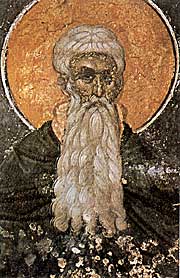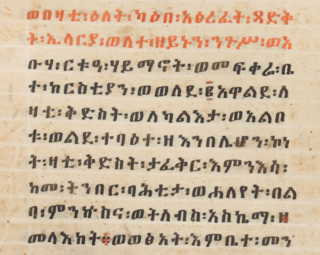Related Research Articles

Moses the Black, also known as Moses the Strong, Moses the Abyssinian, Moses the Robber, and Moses the Ethiopian, was an ascetic monk and priest in Egypt in the fourth century AD, and a Desert Father. He is highly venerated in the Eastern Orthodox Church and the Oriental Orthodox Church. According to stories about him, he converted from a life of crime to one of asceticism. He is mentioned in Sozomen's Ecclesiastical History, written about 70 years after Moses's death.

The Desert Fathers or Desert Monks were early Christian hermits and ascetics, who lived primarily in the Scetes desert of the Roman province of Egypt, beginning around the third century AD. The Apophthegmata Patrum is a collection of the wisdom of some of the early desert monks and nuns, in print as Sayings of the Desert Fathers. The first Desert Father was Paul of Thebes, and the most well known was Anthony the Great, who moved to the desert in AD 270–271 and became known as both the father and founder of desert monasticism. By the time Anthony had died in AD 356, thousands of monks and nuns had been drawn to living in the desert following Anthony's example, leading his biographer, Athanasius of Alexandria, to write that "the desert had become a city." The Desert Fathers had a major influence on the development of Christianity.

A skete ( ) is a monastic community in Eastern Christianity that allows relative isolation for monks, but also allows for communal services and the safety of shared resources and protection. It is one of four types of early monastic orders, along with the eremitic, lavritic and coenobitic, that became popular during the early formation of the Christian Church.

Arsenius the Deacon, sometimes known as Arsenius of Scetis and Turah, Arsenius the Roman or Arsenius the Great, was a Roman imperial tutor who became an anchorite in Egypt, one of the most highly regarded of the Desert Fathers, whose teachings were greatly influential on the development of asceticism and the contemplative life.

Wadi El Natrun is a depression in northern Egypt that is located 23 m (75 ft) below sea level and 38 m (125 ft) below the Nile River level. The valley contains several alkaline lakes, natron-rich salt deposits, salt marshes and freshwater marshes.
Venerable Zachariah the Recluse of Egypt was an Egyptian Christian monk who lived during the 4th century in Scetis, Lower Egypt. He is the patron saint of society's outcasts. He served the homeless and poor, and is remembered as a monastic father.

The Sayings of the Desert Fathers is the name given to various textual collections consisting of stories and sayings attributed to the Desert Fathers and Desert Mothers from approximately the 5th century AD.

Abba Poemen the Great was a Christian monk and early Desert Father who is the most quoted Abba (Father) in the Apophthegmata Patrum. Abba Poemen was quoted most often for his gift as a spiritual guide, reflected in the name "Poemen" ("Shepherd"), rather than for his asceticism. He is considered a saint in Eastern Christianity. His feast day is August 27 in the Julian calendar.
Nitria is one of the earliest Christian monastic sites in Egypt and is located in the Nitrian Desert. It was the first of the three major centers of Christian monastic activity in the Lower Egypt, the other two being Kellia and Scetis.
The Asceticon by Abba Isaiah of Scetis is a diverse anthology of essays by an Egyptian Christian monk who left Scetis around 450 AD.
The Forty-Nine Martyrs of Scetis were Christian monks of the monasteries of Scetis in Roman Egypt who were massacred by Berbers during a raid in 444. Two laymen were martyred along with them. Their relics lie in the Monastery of Saint Macarius the Great. They are venerated in the Coptic Orthodox Church, but not in the Eastern Orthodox or Roman Catholic churches.
Pherme was the location of a community of ascetic monks in the Nile Delta in Egypt which grew after the 4th century CE as a satellite community of the better known community of Kellia.

The Legend of Hilaria is a Coptic romance, possibly a Christian version of the pagan Tale of Bentresh. It was written between the 6th and 9th centuries AD. During the Middle Ages, it was translated into Syriac, Arabic and Ethiopic. It tells the tale of Hilaria, daughter of the Roman emperor Zeno, who disguised herself as a man to become a monk and later heals her sister of an ailment. The tale was incorporated into the synaxaries of the Oriental Orthodox churches, and Hilaria came to be celebrated as a saint.
Isaiah the Solitary, also known as Isaiah of Gaza, Isaias the Solitary, Abba Isaiah, or possibly also Isaiah of Scetis, was a Christian ascetic and monastic writer known from the Sayings of the Desert Fathers and various Palestinian Miaphysite sources. He is canonized as a saint by the Coptic Orthodox Church, with his feast day on the 11th day of the month Abib (Epip) in the Coptic calendar.
Saint Pior was an Egyptian monk and hermit in the desert of Scetis, one of the Desert Fathers, and a disciple of Anthony the Great. He lived to a great age. His feast day is 17 June.
Abba Silvanus was a Palestinian Christian monk who lived during the 4th and 5th centuries. He was one of the Desert Fathers.
Abba Agathon was an Egyptian Orthodox Christian monk and saint who lived around the 4th century in Scetis, Lower Egypt and was known for his meekness and discernment. He was a disciple of Abba Lot and Abba Poemen and a contemporary of notable Desert Fathers Amun, Macarius, Joseph and Peter. He is venerated as a saint in the Orthodox Church on March 2. Agathon was one of the Desert Fathers.
AbbaAnoub, also known as Anoub of Scetis or Anoubius, was an Egyptian Eastern Orthodox Christian Saint, ascetic and anchorite who lived during the 4th and 5th centuries in Scetis, Lower Egypt. Abba Anoub is mentioned in the Sayings of the Desert Fathers, also called the Apophthegmata or the Gerontikon. Saint Nikolaj Velimirović says, "Anoubius was one of the great Egyptian monks." Abba Anoub was one of the Desert Fathers.
Theodore of Enaton was an Egyptian Christian monk who lived in the monastery of Enaton in Lower Egypt during the 4th century. He was one of the Desert Fathers. Theodore of Enaton was a disciple of Abba Amoun and was also a companion of Abba Or.
Carion the Egyptian was an Egyptian Christian monk who lived during the 4th century in Scetis, Lower Egypt. He was one of the Desert Fathers.
References
- 1 2 3 "Abba Theodore of Pherme". Wind Ministries. 2018-07-13. Retrieved 2021-11-15.
- ↑ Ward, Benedicta (1984). The sayings of the Desert Fathers: the alphabetical collection. Kalamazoo, MI: Cistercian Publications. ISBN 0-87907-959-2.